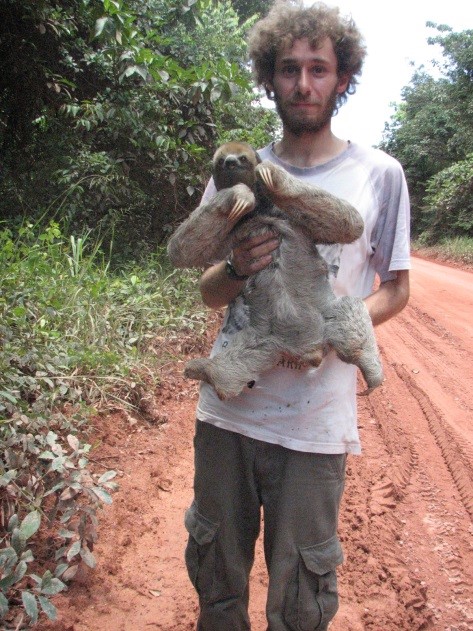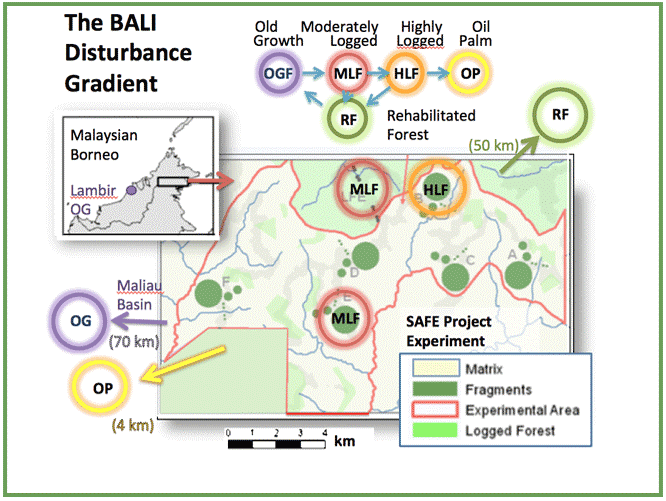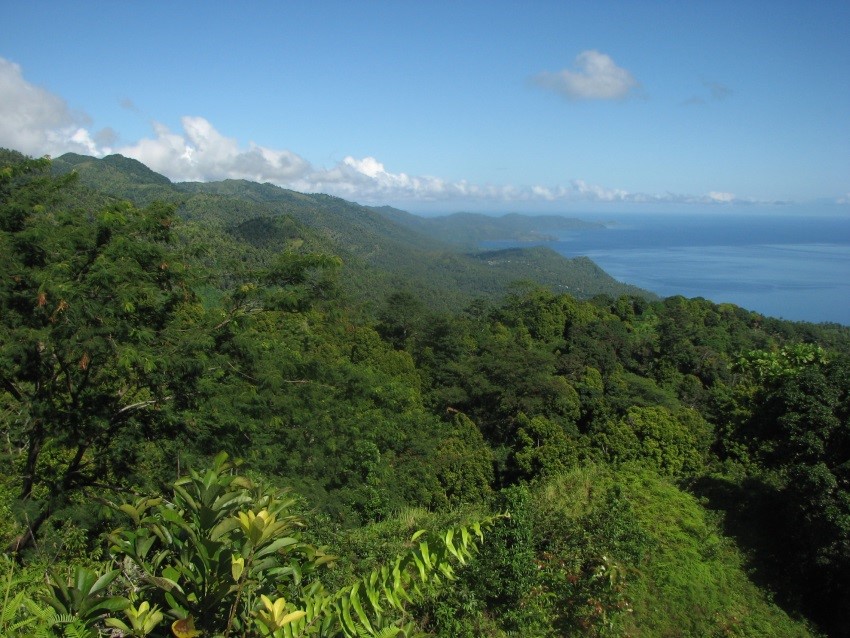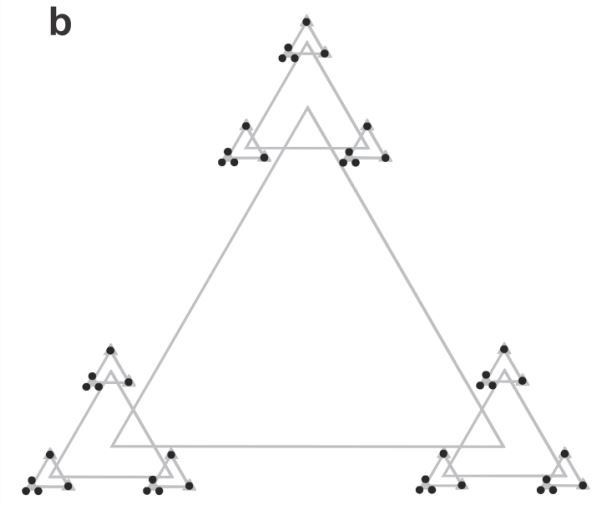I am a postdoc working on the BALI (Biodiversity And Land-use Impacts of Tropical Ecosystem Function) project. The project aims to explore the biogeochemical impacts of tropical forest degradation, agricultural conversion and biodiversity loss. It’s based in Sabah, in the north of Borneo, which has some of the oldest and most biodiverse rainforests on earth.
postdoc working on the BALI (Biodiversity And Land-use Impacts of Tropical Ecosystem Function) project. The project aims to explore the biogeochemical impacts of tropical forest degradation, agricultural conversion and biodiversity loss. It’s based in Sabah, in the north of Borneo, which has some of the oldest and most biodiverse rainforests on earth.
The project aims to understand:
1) how land-use change in Malaysian Borneo has altered the functional diversity of tropical forest ecosystems
2) the consequences of these changes in functional diversity for biogeochemical cycling and trace gas exchange;
3) the wider implications of these human perturbations for biogeochemical cycling and atmospheric composition at the landscape-scale.
Our job is project synthesis, trying to make sense of all the incredible amount and variety of data collected on BALI, ranging from leaf traits to fungi biodiversity to decomposition rates from termites. We will explore all these things along a deforestation gradient of primary forest to forest that has been selectively logged in the past, through to oil palm monocultures.
BALI is a member of the wider Acronyms Assemble group of the HMTF (Human-Modified Tropical Forest) project along with LOMBOK (Land-use Options for Maintaining Biodiversity and Ek(?)osystem functions) and ECOFOR (Biodiversity and Ecosystem Functioning in Degraded and Recovering Amazonian and Atlantic Forests), all funded through NERC (Natural Environment Research Council), with data mainly collected from SAFE (Stability of Altered Forest Ecosystems). Beat that.
I’m also working on Andy’s Sabah Biodiversity Experiment (www.sabahbiodiversityexperiment.org) where we will be looking at how the surrounding trees have affected the sapling growth and survival. The surrounding trees have been measured by Martin Svátek and co at really high resolution using lasers and Field-Map (www.fieldmap.cz). Does being surrounded by lots of other trees mean that you will be shaded out, or does it mean that you’re in a good environment and will do well?
Previous work:
Generally my work fits in to two categories – tropical ecology and computation ecology, so when I’m not lucky enough to be running around the rainforest I’m sat in front of R. Masters and undergrad work focussed on birds and butterflies in the Comoros Islands between Madagascar and Africa. Even for an island archipelago it has a huge deforestation but lots of endemic species. See my friend Hugh Doulton’s work out there helping local people find solutions at https://daharicomores.org
My PhD focussed on fragmentation and β-diversity, using dung beetles and ants in Brazil in Rob Ewers’ group at Imperial College London. We used a sampling design based on fractal triangles that allows you to decompose patterns into different spatial scales, which is how the SAFE project is also organised. Not much fun cutting the trails but it seems to work.
My postdoc was based in Bill Kunin’s lab in University of Leeds (also a short stint with Neil Brummitt in the Natural History Museum). Mainly computational ecology this, involving a lot of simulations, as part of two EU projects (EU-BON and SCALES). Broadly there were two themes, one is how we important scale of observation (grain size and extent) is to looking at ecological processes and how we might use it, and two was using a lot of the fragmented and variable biodiversity data available across the EU. A lot of work was on improving species distribution models, such as developing the alpha-adjusted SDM which incorporates predicted species richness in to SDMs, and also downscaling the occupancy-area relationship. Basically as grain size increases so the area of occupancy increases. The idea is that you can take atlas data at really large grain sizes and use it to predict area of occupancy at smaller grain sizes, for example for red-listing. We made a nice R package, downscale, for this as well. Check out some of the publications below of Yoni Gavish and Richard Gunton for these collaborations.
Contact Details:
Charliem2003@gmail.com (preferred)
Charles.marsh@plants.ox.ac.uk
Publications:
In press:
Pfeifer M, Lefebvre V, Peres CA, Banks-Leite C, Wearn O, Marsh CJ…, Ewers RM (in press) Creation of forest edges has a global impact on forest vertebrates. Nature.
Marsh, C.J., Barwell, Louise, J., Gavish, Y., Kunin, W.E. (in press) downscale: An R package for downscaling species occupancy from coarse-grain data to predict occupancy at fine-grain sizes. Journal of Statistical Software.
Gavish, Y. O’Connell, J., Marsh, C.J., Kunin, W.E., Tarantino, C., Tomaselli, V, Blonda, P. (in press) Comparing the performance of flat and hierarchical habitat/land-cover classification models in a NATURA 2000 site. ISPRS Journal of Photogrammetry and Remote Sensing.
Published:
Gavish Y., Marsh C.J., Kuemmerlen M., Stoll S., Haase P., & Kunin W.E. (2017) Accounting for biotic interactions through alpha-diversity constraints in stacked species distribution models. Methods in Ecology and Evolution, 8, 1092–1102.
Gunton R.M., Marsh C.J., Moulherat S., Malchow A.-K., Bocedi G., Klenke R.A., & Kunin W.E. (2017) Multicriterion trade-offs and synergies for spatial conservation planning. Journal of Applied Ecology, 54, 903–913.
Brummitt N., Regan E.C., Weatherdon L. V, Martin C.S., Geijzendorffer I.R., Rocchini D., Gavish Y., Haase P., Marsh C.J., & Schmeller D.S. (2017) Taking stock of nature: essential biodiversity variables explained. Biological Conservation, 213, 252–255.
Hudson L.N., Newbold T., Contu S., Hill S.L.L., Lysenko I., De Palma A., Phillips H.R.P., … Marsh C.J.,…Purvis A. (2017) The database of the PREDICTS (Projecting Responses of Ecological Diversity In Changing Terrestrial Systems) project. Ecology and Evolution, 7, 145–188.
Griffith D.M., Veech J.A., & Marsh C.J. (2016) cooccur: Probabilistic Species Co-Occurrence Analysis in R. Journal of Statistical Software, 69, 1–17.
Pfeifer M., Lefebvre V., Gardner T.A., … Marsh C.J.,…Ewers R.M. (2014) BIOFRAG – a new database for analyzing BIOdiversity responses to forest FRAGmentation. Ecology and Evolution, n/a-n/a.
Marsh C.J. & Ewers R.M. (2013) A fractal-based sampling design for ecological surveys quantifying β-diversity. Methods in Ecology and Evolution, 4, 63–72.
Marsh C.J., Louzada J.N.C., Beiroz W., & Ewers R.M. (2013) Optimising bait for pitfall trapping of amazonian dung beetles (Coleoptera: Scarabaeinae). PLoS ONE, 8, e73147.
Marsh C.J., Lewis O.T., Said I., & Ewers R.M. (2010) Community-level diversity modelling of birds and butterflies on Anjouan, Comoro Islands. Biological Conservation, 143, 1364–1374.
Ewers R.M., Marsh C.J., & Wearn O.R. (2010) Making statistics biologically relevant in fragmented landscapes. Trends in Ecology and Evolution, 25, 699–704.
Lee M., Manning P., Rist J., Power S.A., & Marsh C.J. (2010) A global comparison of grassland biomass responses to CO2 and nitrogen enrichment. Philosophical transactions of the Royal Society of London. Series B, Biological sciences, 365, 2047–56.
Megson S., Mitchell P., Köhler J., Marsh C.J., Franzen M., Glaw F., & Cruze N.D. (2009) A comprehensive survey of amphibians and reptiles in the extreme north of Madagascar. Herpetology Notes, 2, 31–44.




